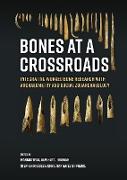Bones at a crossroads
BücherAngebote / Angebote:
Bone tool studies are at a crossroads. A current path is to go beyond the concatenation of methods or concepts borrowed from other disciplines and aim instead at a truly integrated approach that is more in line with the objectives of interdisciplinary and transdisciplinary research.The papers in this volume follow this direction by adopting various forms of dialogue and integration between old and new methods and approaches, including technological analysis, usewear analysis, typology, zooarchaeology, stable isotope analysis, experimental archaeology or spatial analysis. They represent a mixture of methodological issues, case studies, and discussions of larger cultural and historical phenomena that span thousands of years and many parts of the World, from South Asia to the Near East and Europe, and from North to South America. The synergies deriving from these multi-perspective approaches lead to the repeated identification of diverse social aspects of past societies, including the identification of general social contexts of bone tool production and use, transmission of knowledge, the symbolic dimensions of artifacts, and intergroup relations as well as warfare and state formation processes.All these papers grew out of communications presented at the 13th meeting of the Worked Bone Research Group (WBRG) on October 7th-13th, 2019, at the Département d'anthropologie, Université de Montréal, Canada. The WBRG is an official working group of the International Council for Archaeozoology (ICAZ) dealing with the study of worked faunal remains from archaeological sites.ContentsOsseous arrowheads in the Iron Age of the Upper Ganga PlainsVinayakUncovering some aspects of the worked bone assemblages from Periods I-III (Neolithic to Pre-Northern Black Polished Ware with Iron Cultures) of Agiabir, IndiaRavi Shankar, Pramod P. Joglekar, Sharada Channarayapatna, and Ashok Kumar SinghMagnifying the differences: Investigating variability in Dorset Paleo-Inuit organic material culture using microscopic analysisMatilda I. Siebrecht, Sean P. A. Desjardins, Sarah M. Hazell, Susan Lofthouse, Elsa Cencig, Katie Kotar, Peter D. Jordan, and Annelou van GijnAntler as raw material among hunter-gatherer groups from the Pampean Region (Argentina)Natacha Buc, Alejandro A. Acosta, and Lucía T. RomboláOsseous artifacts from the Maros-culture necropolis at Ostojicevo (northern Serbia)Selena VitezovicAn antler workshop in a Germanic settlement in Nitra, SlovakiaGertrúda Brezinová and Erik HrnciarikThe worked bone and tooth assemblage from Piaçaguera: Insights and challengesDaniela KloklerTraceological evaluation of bone instruments as an indirect indicator: Rebuilding textile technology during the Ceramic period on Mocha Island (Chile)Helga Inostroza RojasA microscopic view of Maya needle and perforator production at Ucanal, GuatemalaCarolyn Freiwald, Christina Halperin, Camille Dubois-Francoeur, Caroline Schlinsog, and Kimberly A. BauerWarm it up! Using experimental archaeology to test shark teeth extraction hypothesesSimon-Pierre Gilson and Andrea LessaCrafting white-tailed deer (Odocoileus virginianus) bone and antler at Cerro Juan Díaz (LS-3), Greater Coclé Culture Area, PanamaMaría Fernanda Martínez-Polanco, Luis Alberto Sánchez-Herrera, Máximo Jiménez-Acosta, and Richard G. CookePreliminary spatial analysis of the morphologically identifiable bone tools from an Early Bronze Age III domestic building in a residential neighborhood house at Tell e¿-¿âfi/Gath (Stratum E5c)Sarah J. Richardson, Haskel J. Greenfield, Tina L. Greenfield, and Aren M. MaeirA Woodland-period bone tool industry on the northern Gulf of Mexico coastal plainGregory A. Waselkov, Sarah E. Price, Alexandra Stenson, Carla S. Hadden, and Long DinhThe many dimensions of a boneMarie-Ève Boisvert, Claire St-Germain, and Christian Gates St-Pierre
Folgt in ca. 10 Arbeitstagen
